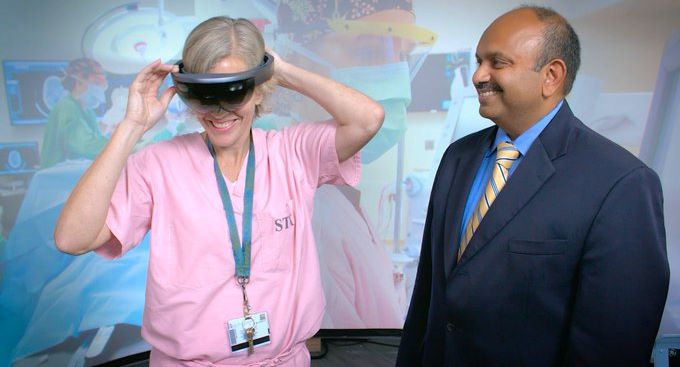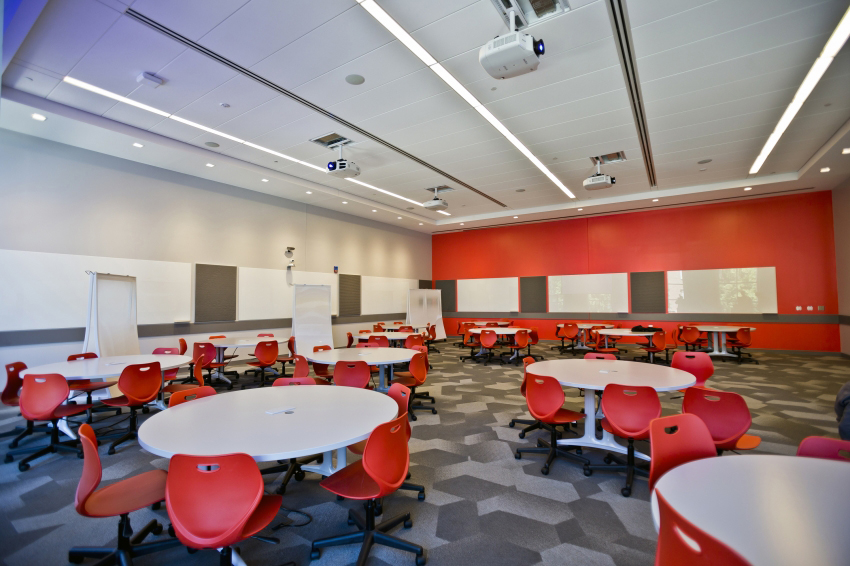University of Maryland Institute for Advanced Computer Studies
A noted Baltimore philanthropic organization has awarded a $50,000 grant to the Maryland Blended Reality Center (MBRC) in support of using new immersive technologies for education, humanitarian purposes and social change.
The grant from the Edward St. John Foundation supports MBRC’s development of innovative devices and education modules that use virtual and augmented reality. These immersive tools—which combine high-end computer graphics with intuitive user interfaces—are already being prototyped and tested by MBRC for medical diagnostics, surgical training, non-opioid pain management, the performing arts, and more.
“The Edward St. John Foundation is proud to support the dedication and leadership of the Maryland Blended Reality Center’s co-directors, Sarah Murthi and Amitabh Varshney, as they develop new tools and technologies that can transform healthcare and education and encourage social change,” says Sharon L. Akers, president of the foundation. “We’re particularly gratified that some of their work is already benefiting Baltimore area residents, and we look forward to the center expanding its education and outreach efforts.”
The $50,000 grant from the Edward St. John Foundation is being matched by $25,000 from the University of Maryland, College Park, and $25,000 from the R Adams Cowley Shock Trauma Center, University of Maryland.
Murthi, an associate professor of surgery at the University of Maryland School of Medicine, and Varshney, a professor of computer science and dean of the College of Computer, Mathematical, and Natural Sciences, are working closely with officials at the Edward St. John Foundation to determine specific uses for the new funding.
New initiatives will include expanding MBRC’s efforts in the development of virtual reality tools for surgical education and training; summer internships for students interested in using immersive technologies for social change; and assisting people with limited mobility to experience new sights and sounds that previously might have been inaccessible, while simultaneously reducing their use of opioids for pain management.
MBRC was launched in 2017, joining physicians and clinicians at the University of Maryland, Baltimore, with computer science experts at the University of Maryland, College Park. Originally funded by the University of Maryland Strategic Partnership: MPowering the State, the center has since received additional funding from the National Science Foundation, the National Institutes of Health, the Department of Defense and the Prince George’s County Police Department.
“The accomplishments of the center thus far serve as a wonderful example of what can be achieved when the state’s top public research universities—the University Maryland, College Park, and the University of Maryland, Baltimore—join forces with what is often considered the finest trauma care facility in the world, R Adams Cowley Shock Trauma, to create strategic partnerships to realize tremendous goals and outcomes,” says Akers. “MBRC is truly representative of the importance of collaboration, drawing on the best and brightest to innovate and establish benchmarking success.”
Early projects out of MBRC focused on new diagnostic tools to assist physicians at Shock Trauma, where Murthi is a trauma surgeon and director of the critical care ultrasound unit. In 2018, Murthi and Varshney co-authored an op-ed in the Harvard Business Review that detailed how augmented reality could improve patient care and lower costs in hospital settings.
“With the support from the Edward St. John Foundation, we want to modify tools originally created by the MBRC for hospital medical applications, and tailor them for educational, artistic and humanitarian purposes,” says Murthi.
More recently, MBRC partnered with the Maryland Institute College of Art to test the use of virtual reality to help patients cope with spinal cord injuries. The center has also worked with the Prince George’s County Police Department to develop simulation-based virtual reality training modules to help officers recognize unconscious attitudes of implicit bias in their policing.
The performing arts is another area where MBRC is designing new virtual reality applications. One project involves virtually transporting viewers around the world to scenic locations that represent diverse solo violin pieces; another lets viewers virtually move about onstage during an opera performance.
“Our work has been steadily focused on improving educational experiences and medical outcomes for Maryland residents, and we’ve recently been drawn into exploring new ways for people to experience the performing arts—also very meaningful in our society,” says Varshney. “With support from the Edward St. John Foundation, we expect to have an even greater impact on improving people’s lives everywhere.”
About the Edward St. John Foundation: Established in 1998 by Baltimore real estate developer Edward St. John, the Edward St. John Foundation focuses on educational enrichment for children and other worthwhile causes. To date, more than $65 million has been pledged and donated through outright contributions or gifts-in-kind to over 350 educational and other nonprofit organizations throughout the Baltimore/Washington region.


